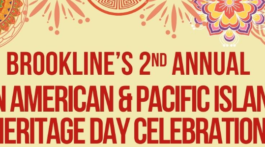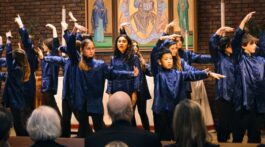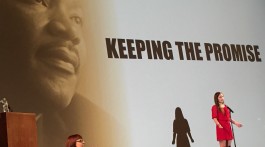By Tanner Stening
Activists from Brookline came together to voice their opinions on social justice and equality at the annual Dr. Martin Luther King Jr. Day celebration Monday at the Coolidge Corner Theater.
Protesters gathered outside the theatre holding signs that called for the removal of the Board of Selectmen in light of the recent controversy involving allegations of racism in the Brookline Police Department.
Bernard Greene, Chairman of the MLK Event Committee and the first African-American elected to Brookline’s Board of Selectmen, addressed the audience inside the theater at the beginning of the celebration.
“There will be time for questions towards the end of the presentation,” Greene said. “So use that opportunity wisely.”
The program included readings by Brookline poet laureate Jan Schreiber, Boston-based slam poet Regie Gibson, and 18-year-old Brookline High School student Hannah Timmermann. Schreiber read a poem by Langston Hughes and Timmerman performed a slam piece called How to Tell Your Racist Family that You Held the Hand of a Black Boy.
Chief Diversity Officer Lloyd Gellineau was also among the presenters. He spoke about his childhood and how he wanted to grow up to be just like Dr. King.
The keynote presenter was Northeastern University Law Professor Susan Maze-Rothstein who gave a lengthy lecture that sought to examine the “mostly invisible ways that racism affects all of us.”
Several video presentations were played to supplement her lecture. One video included footage of President Obama describing the experiences he had with the police when he was younger. During the presentation there was an interactive discussion about what Maze-Rothstein describes as a society “sick with anger and outrage surrounding unresolved and unaddressed issues of race.”
Meanwhile outside the theater, protesters from organizations such as the First Parish Church in Brookline stood in solidarity with the two police officers that allege discrimination from other officers.
“It’s easy to throw around the word racism,” Greene said before the event. “The useful and meaningful question is: what has the town done to minimize the instances of racism? The answer: respond immediately, which we’ve done.”
This question, along with other related issues, were explored during the lecture when Maze-Rothstein engaged the audience with a series of questions and statements designed to examine how racism is embedded in social hierarchy, or white privilege, a term originally coined by activist and historian W.E.B. Du Bois.
“If you’re family taught you that the police were to be trusted, raise your hand.” She asked the audience. “And if you’re family taught you that the police were to be feared, raise your hand.”
Throughout the exercise hands seemed to be raised along racial and socioeconomic lines. A majority raised their hands to such directives as “grew up with friends who went on to attend Ivy League universities” or “have parents or family members who are doctors, lawyers, or professors.” Far fewer hands were raised for “brought up by a single parent.”
The foundation of Maze-Rothstein’s lecture rested on ideas put forth in two influential academic papers entitled White By Law and White Fragility, which aided in the discussion about the complexity of issues surrounding race in society today.
“There is a kind of fierce urgency felt in our society,” said Maze-Rothstein. “What can we do to make sure this isn’t just a ‘sham’ MLK event? We can adopt these three skills: the ability to shift our perspective, the ability to think in levels of abstraction, and the ability to embrace some level of discomfort.”
The rest of the lecture focused on a new approach to dealing with issues surrounding race, violence and community-building, more generally known as restorative justice, a process of conflict resolution that believes in bringing together the wrongdoer and the associated parties in a way best conducive to “healing and reintegration.”
The restorative justice process is put forward by The Institute for Restorative Initiatives (IRIS), an organization founded in 2013 that provides training and research to schools and larger communities on the development, implementation and evaluation of restorative practices.
Following the presentation, there was a Q&A period where several community members voiced their concerns over the restorative justice process, stressing the need for practical solutions and mutual responsibility in instances of racism. One woman questioned its practicality, fearing it was not realistic to implement. Former Selectman Marty Rosenthal said the process, which was laid out on a notecard given out towards the end of the lecture, “blurs into retribution, and retribution blurs into revenge.”
The exchanges proceeded peacefully, as did the demonstration outside the theatre, which ended shortly after the event began.
Previous coverage on the case of Prentice Pilot and Estifanos Zerai:
Message From Police Chief Daniel C. O’Leary
Town Releases Results of Police and Fire Racial Climate Review
Audio From January 5 Board of Selectmen Hearing on Police Racial Discrimination












